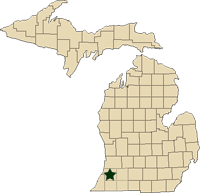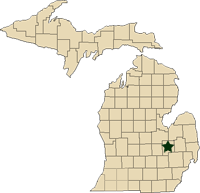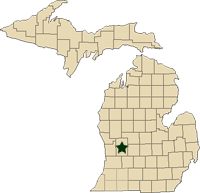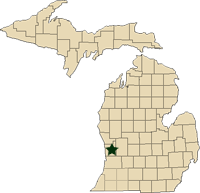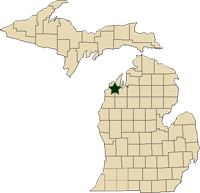Regional reports on Michigan fruit – April 10, 2012
MSU Extension educators’ pest and fruit updates for Michigan.
This week’s regional reports:
- Southwest Michigan - Mark Longstroth, Bill Shane, Diane Brown
- Southeast Michigan - Bob Tritten
- Grand Rapids Area Tree Fruit - Amy Irish Brown and Phil Schwallier
- Grand Rapids Area Small Fruit – Carlos García-Salazar
- Northwest Michigan - Nikki Rothwell, Duke Elsner, Erin Lizotte
Southwest Michigan – Mark Longstroth, Bill Shane, Diane Brown, Michigan State University Extension
|
Weather
Plant growth remained slow last week. Highs were in the 60s and lows in the 40s. Freezes occurred on Friday, April 6 (see Enviro-weather’s report), and Saturday, April 7 (see Enviro-weather’s report). Low temperatures both mornings were in the mid-20s. These freezes were wide spread and damage is spotty, generally at lower fruit sites where cold air collected under calm conditions. Friday was a black frost with no frost forming on the ground. This indicates the low temperatures were well above the dewpoint. Friday’s freeze was more uniform with most of the region falling to lows in the 20s. Damage on Friday in Van Buren County seemed light for the low temperatures observed. Saturday’s freeze had wide spread frost indicating the low was at or below the dewpoint. Fruit sites with good air drainage where much warmer on Saturday than Friday – several remained above freezing. Damage from Saturday’s freeze seemed more severe.
Windy, wet weather with lows near freezing is forecast for the next few days. There is little chance that the damaging lows will occur for the next few days. Another radiation freeze is likely on Thursday (April 12). This weekend will be warmer with highs in the 70s and lows in the 50s, with a good chance of showers and thundershowers. Many plants look weak, with reddish or yellow leaves from the cool soils. Dry weather has also slowed nitrogen uptake. Soil temperatures are in the 50s. Sandy soils are becoming very dry. Our growing degree day accumulations across the region are very uniform. It is unusual that there is very little difference between stations.
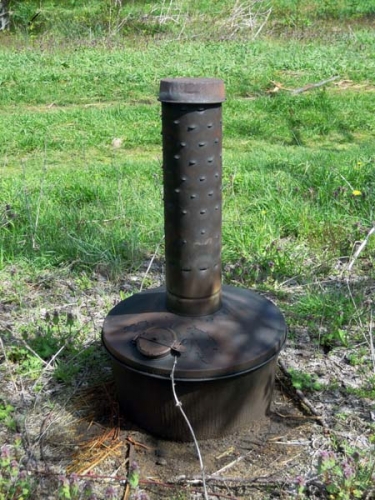
Smug pots were used in some orchards last week.
Tree fruit
Bloom progressed slowly this last week due to the cool weather. Generally there appears to be enough bees now. It will be important to get trickle irrigation started quickly on newly planted sites due to generally dry soils. Soaking tree roots before planting will help new trees get a better start. Rapid plant development this spring made it difficult for growers to get herbicides on in a timely fashion. Recent rains were too short and cold to be brown rot or apple scab infections.
Apricots are 10 to 14 mm in diameter.
Peaches are in the shuck. There is still a good amount of fruit, especially in good peach sites. Oriental fruit moths were being trapped in good numbers on April 2. We think it would be good to set a new biofix based on when warm weather returns. Aphids and cat-facing insect such as tarnished plant are out. Tarnished plant bugs are generally not a concern until fruit start emerging from the shuck.
Sweet cherries are in the shuck and early varieties are at shuck split. Orchards in poor sites suffered significant damage to the recent freezes, but a good crop remains in orchards on good sites. New leaves have emerged and protectants for cherry leaf spot will be needed. Cherry leaf spot can only infect mature leaves with functional stomates.
Tart cherry bloom is ending and many fruit are in the shuck. It will be several weeks before the extent of fruit set can be determined. There are plenty of small, green cherries in the shucks. The trees are leafing out and controls for cherry leaf spot need to be applied. Orchards receiving Rovral or SI fungicides for brown rot during bloom have only a weak coverage in place for cherry leaf spot control.
In plums, Japanese plums are in the shuck. European plum bloom is ending. Black knot requires wet conditions for infection and growers should be maintaining controls.
Apple bloom ranges widely from king bloom to full bloom to petal fall, depending on the variety and site. The average full bloom date for apples in southwest Michigan normally is May 6 and 9 for different varieties. Growers report light return bloom in some varieties such as Jonathan, Golden and Red Delicious. Damage from recent freezes is spotty. Some orchards show little damage. Most orchards show some damage, but still retain enough flowers for a good crop of fruit.
Apple scab symptoms should be visible from the March 22 infection period. Growers can use the scab infection tool on Enviro-weather to track when scab symptoms will be visible. Bloom is the time to begin monitoring conditions favoring fire blight – Enviro-weather has two methods for tracking fire blight episodes. The cool weather has been unfavorable for fire blight development, but warm wet weather is forecast later in the week so fireblight will be a concern where bloom is present.
Powdery mildew symptoms, both primary infections from last year and secondary spread, are easy to see on crabapples. Cool conditions, infrequent rains, and high humidity favor this disease.
Pear bloom is ending. It is hard to assess the effect of the freeze at this time. Growers will need to protect against pear scab and watch for fire blight conditions.
Small fruit
Grape growth has been slow due to the cool temperatures. Development is scattered with swollen buds and elongated shoots on the same canes. The freeze caused widespread and spotty damage. With another few weeks to go until we reach the normal frost-free date, it is too early to determine crop levels. Damage will be easier to assess when warm weather returns and growth begins again. Growers should map out frost damage in vineyards and make decisions about fungicide protection accordingly.
So far, weather has been quite dry. The cool, rainy weather forecast for this weekend means that phomopsis infections can be more of a problem. Sprays to protect against phomopsis should be applied as the flower clusters become exposed. Temperatures in the 60 to 70 degree range are optimum for phomopsis, and only six to 10 hours of wetness is needed for infections to occur. At 50°F, a minimum of 15 to 20 hours of wetness is needed for infection to occur. Protective sprays of mancozeb or half mancozeb half phosphorus acid products may be a useful combination for these early season phomopsis applications.
For wine grapes, powdery mildew may be a concern. Infections can occur at temperatures in the 50s.
Blueberries are at pink bud and bloom is beginning in early varieties such as Bluejay, Concord, Bluetta and Bluecrop. Colder weather has caused leaves to redden and the leaves seem small for the bloom stage. Friday and Saturday’s freezes caused very little damage and that was only in the few fields with open bloom. Cranberry fruitworm traps should be out before bloom.
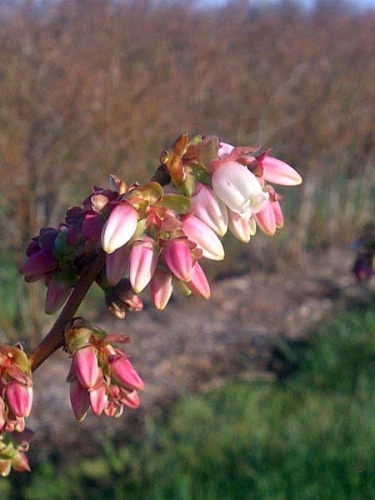
Bluetta bloom near Paw Paw, Mich.
Strawberry flower trusses are emerging from the crown in many matted row plantings. In strawberry plantings without sprinklers for freeze protection, many flowers have black centers, indicating freeze injury. Small fruits are forming on the strawberries grown on raised beds with black plastic at Southwest Michigan Research and Extension Center (SWMREC).
In brambles, new leaves are unfolding. Flower clusters are visible in some early summer varieties.
Cranberry beds have been protected from the recent freezes and some are showing areas of green.
Upcoming meetings
Our next Monday fruit meetings will be April 9 at Fruit Acres Farms at 5 p.m.
The first in-season grape meeting is scheduled on April 25 at SWMREC from 3-8 p.m. This meeting will feature sprayer calibration, rate controllers, and sprayer setup for early season canopies. Mark Ledebuhr from Application Insight, LLC and John Stone from MSU’s Pesticide Safety Education Program will be conducting this in-field workshop. Registration is $25, including supper.
Register for the meeting by sending in the form or contacting the Berrien County Extension office at 269-944-4126. Although on-site registration will be available, registration a week in advance of the meeting would be appreciated to allow for meal planning.
Southeast Michigan – Bob Tritten, Michigan State University Extension
|
Weather
Most of our fruit crops have been in a holding pattern for the last week in terms of our flowering stage. I have never seen a season where peaches have been in bloom this long. The same holds true of ornamental plants, like forsythia. It is now official that March was the warmest on record for even our oldest weather reporting stations. We experienced our second and third frost and freeze events for the season last Friday and Saturday mornings (April 6-7), with temperatures at a few Enviro-weather stations dipping to 23°F. This cold event caused additional flower bud damage to tart cherries and apples. Peaches are the only tree fruit crop that appears to be uninjured from these freeze events.
Our early warm season is running between three and four weeks ahead of normal in terms of growth stages, and even more than that in terms of degree day totals. I do not see nearly as much spread in growth stages from south to north as I do in most years. We are generally vulnerable to frost and freeze events for the next four to five weeks.
Our soils remain very warm for this time of the season, with soil moisture supplies running on the dry side for many farms. Planting of both tree and small fruits are well along this season.
We have had excellent honey bee survival through the winter, with almost all hives surviving. Honey bees have not been flying much over the last week with cool temperatures on most days. Bumble bee flight has been very strong this season.
East Michigan Growing Degree Day Totals for March 1-April 9 | |||
|
Location |
GDD42 |
GDD45 |
GDD50 |
|
350 |
283 |
187 | |
|
325 |
263 |
173 | |
|
Flint (Genesee) |
381 |
310 |
210 |
|
369 |
304 |
208 | |
|
389 |
316 |
211 | |
|
305 |
244 |
162 | |
|
336 |
270 |
175 | |
Tree fruits
Apples have been stalled at full pink for the last week. Yesterday (April 9) I saw an Idared block that had 10 percent king bloom open. These are the first kings I have seen open this season. I expect to see full bloom by late this week or over the weekend.
The full extent of the freeze injury is still playing itself out. It appears that there is a lot of king bloom loss in apples from the Ann Arbor, Mich., area and to the north. There is also some side bloom damage. I estimate that where there is damage that we have lost almost half of the bloom. There are enough viable apple flower buds for a full crop, with the outside chance of an excellent crop.
Insect pressure resumed this past week. Oriental fruit moth catch started this week, with most farms only averaging three to five per trap. Spotted tentiform leafminer adults are being caught in traps in the 200 to 300 range. Redbanded leafrollers are being caught in high numbers. We are catching the normal number of apple scab spores at both of our monitoring stations. Most growers report that they have had two apple scab infections for the season.
I am concerned about how yellow and sickly the leaves look on apples. I am hopeful that the warm temperatures predicted for this weekend will help them look better.
Pears are at full bloom. The extent of the frost damage is now becoming more apparent, with a good number of freeze damaged buds being seen. We have had a significant crop loss in pears. There is still some unopened side bloom that has less damage. Pear psylla adults continue to fly, with egg hatch now occurring.
Peaches have been at full bloom for the last three weeks, the longest bloom I have ever seen. The bloom looks tough, however. I have not seen any freeze damage in peaches. Oriental fruit moth catch started this week, with most farms only averaging three to five per trap.
Sweet cherries are beyond full bloom and yet not quite at petal fall. Most blocks of sweet cherries have had extensive flower bud damage, where it is hard to find viable buds even in the tops of the trees. The bloom that was hanging on the bottom side of the branch seems to have pulled through the freeze event with less damage.
Tart cherries are approaching full bloom. There is not much spread this year between sweet cherry and tart cherry bloom. Almost half of the flowers that I have checked have been damaged. Brown rot sprays are going on.
Plums remain at full bloom for European types and petal fall for Japanese types. Almost half of the flowers that I have checked have been damaged on Japanese types.
Small fruits
Strawberriesflower trusses have emerged from the crown at most farms, and at others only a few days from emerging. Some strawberry farms have frost protected four to six times in the past week. Where this much frost protection has been done, leaves look tough. I am seeing above average weed pressure in strawberries this season, especially chickweed and volunteer wheat.
Raspberry leaves continue to emerge for summer fruiting types and new canes continue to emerge from the soil for fall bearing types. Many of the emerging canes and leaves were badly burned from the freeze events. These should recover nicely in a few weeks. I am also seeing heavy weed germination in fall bearing raspberries.
Blueberries remain at early pink bud. I do not see freeze injury in any blueberry planting that I have visited in the last two weeks.
Grapes are at bud burst, with a good number of buds being burned back or damaged from the freeze.
Grand Rapids Area Tree Fruit– Amy Irish Brown and Phil Schwallier, Michigan State University Extension
|
Growth stages and weather
Tree growth has not moved forward much at all in the last 10 days. Most apples are just moving into a king bloom stage. Trees continue to look off-color and yellow from the cool weather. You might want to consider adding some foliar fertilizers in with cover sprays to give trees a little boost. This could help with fruit set as well. Trees under stress do not typically set fruit as well. Having good levels of micronutrients in buds can help reduce cold damage slightly as well.
Freezing temperatures in the last two weeks have hurt some tree fruit flowers, but it doesn’t seem to be a lot of damage. Sweet cherries are hurt the worst. With the cool days, it could take a while for us to know the full extent of damage, and, of course, there is likely to be more over time with this early spring situation.
Pollination
Arrangements for honeybee hives need to be in place. It appears that we might have a cool bloom time, so the addition of bumblebee hives would be money well spent this year – bumblebees will work in cooler temperatures when the honeybees stay home. Also, there are reports of bees dying in hives from starvation and cold.
Apple scab
There are several days of rain in the forecast for later this week and a heavy apple scab infection is likely. Good, full fungicide cover sprays are recommended.
Fire blight
With apple bloom opening now, we start the model for blossom blight predictions. The cool temperatures we are in right now pose no risk for blossom blight infection. Slightly warmer weather is in the forecast, but we really need some daytime temperatures above 65 for a few days in a row to cause blossom blight concerns if it rains. While the forecast isn’t favorable today for blossom blight, we all know how fast that can change, so keep an eye on the Enviro-weather models for blossom blight predictions.
Kasumin once again has a Section 18 label for counties in Michigan where streptomycin resistance has been documented. The label is essentially the same as the 2011 version, but you need to have that Section 18 label in hand before you use Kasumin. For more information, see George Sundin’s article, “Kasumin has been granted a Section 18 Specific Exemption for fire blight control for 2012.”
Apogee is applied at king bloom petalfall which might start on some early varieties at any time, so be ready for that. Of course, Apogee helps with management of shoot growth, but it also helps with fire blight suppression.
Using gibberellin plant growth regulators (like Promalin and Perlan) to increase fruit set
We know that the use of gibberellin at King Bloom can increase fruit set. There is some early research that suggests that gibberellin will help set a fruit with no seeds as well. Given this very strange spring, we just don’t know what fruit set will be. The rate is 1 pint per 100 gallons of water. You should leave a check so you can get a fair comparison to learn if it’s helping.
Insects
Insect activity has been almost non-existent. There are a few oriental fruit moths flying, but it’s been difficult to set a biofix yet. No reports of codling moth flight. We could see some codling moth flight with the warmer weather predicted for this weekend in orchards with high pressure. Traps should be up for codling moth and oriental fruit moth in tree fruits. I can find a few aphids on terminals – if you look closely, you can see they are wearing tiny scarves and mittens (just kidding).
Grand Rapids Area Small Fruit– Carlos García-Salazar, Michigan State University Extension
|
For the last seven days, small fruit crops in the Grand Rapids area have remained under a freeze and frost alert since all major crops, blueberries, strawberries and raspberries are in growth stages vulnerable to low temperatures.
Temperatures below 32°F were observed in the entire west central region on April 4-7. Temperatures reached 26°F in some areas, but in general remained above 27°F. The number of hours that the freezing temperatures lasted varied from one to seven hours like on April 6 when the entire central region was below the freezing point. This situation affected mainly strawberries that were already uncovered and growing rapidly due to the previous warm temperatures that occurred during March. Since April 4, growers have been using the sprinkle irrigation system to protect the plants, especially around Ottawa and Kent counties, where the freezing temperatures lasted for one to seven hours on April 4-7.
Similar situation is occurring in raspberries. Most summer raspberries in the Grand Rapids area are in the early stages of growth and growers with sprinkle irrigation are protecting them against freeze and frost damage.
For blueberries, things are much better since their growth stages are not as advanced as those of strawberries or raspberries. So far, blueberries north of Allegan County have been able to stand the low temperatures. Growth stages currently observed in this region go from early pink in mid-to late season varieties, and late pink in the earliest ones. Under these circumstances, blueberries may tolerate up to 25°F with minimum damage.
Our last flower bud damage evaluation on Monday, April 9, around Ottawa County indicated that no damage has occurred due to the freezing temperatures of the past seven days. Prevailing low temperatures during the past week did not advance the flower bud development and the bloom season seems to be within the normal time period.
Regarding pest problems in blueberries, mummy berry mushrooms are out around the Grand Haven, Mich., and Holland, Mich., area with growth that varies between 5 and 10 mm and growers are already applying the second application of fungicides against mummy berry. Since weather condition are favorable for mummy berry infections, growers that have not applied any fungicide yet need to make sure the control is not delayed any longer. Otherwise, they may risk suffering shoot damage that may be confused with winter damage. For fungicides and recommended dose, please check the “2012 Fruit Management Guide” (Extension Bulletin E-154).
No insect problems are showing. Cherry fruitworm traps are out, but no insects have been captured.
Spotted wing Drosophila workshop for berry crops scouts, consultants, and growers
We are programing a half-day work shop for spotted wing Drosophila on April 24 from 1-4 p.m. at the MSU Trevor Nichols Research Center, 6237 124th Avenue, Fennville, Mich. (see map). Attendance will be limited to 20-25 participants. The workshop will include classroom time followed by field hands-on training. Participants will learn how to identify this new insect, how to trap for it, and how to sample fruit for it. This program is designed for growers, scouts, and consultants to learn about spotted wing Drosophila before the field season starts, so management of this pest can be integrated into integrated pest management (IPM) programs.
The cost of attending the workshop will be $30 and this includes training materials and refreshments. Since space is limited to the first 20-25 attendees, please pre-register quickly by calling Judy Hanson, 616-994-4548, at the Ottawa County MSU Extension office.
Northwest Michigan – Nikki Rothwell, Duke Elsner, Erin Lizotte, Michigan State University Extension
|
Weather report
The weather pattern this spring continues to cause headaches for growers in northwest Michigan. Extremely warm temperatures were followed by more seasonal temperatures for April. The cold night temperatures have been a cause for concern over the past week. April 5 had below freezing temperatures, and the morning of April 6 was particularly cold, and temperatures dipped down into the low 20s at two sites. These recent cold nights were followed by a wind freeze event on March 26, which caused some damage to tart cherries across the region.
The weekend was sunny but windy, with the wind coming out of the north which made daytime temperatures feel much colder than reported. Due to the windy conditions, honeybees were not flying this weekend in blooming sweet cherry orchards. We received a small amount of rainfall over the weekend, about 0.2 inches, and this morning (April 10) we have snow flurries potentially changing to rain by the afternoon.
At this time, we have accumulated 315GDD base 42 and 168GDD base 50. Even with the cool-down over the past week, we are at least four weeks ahead of our average, which is 77.8GDD base 42 and 26.3GDD base 50.
Crop report
With last week’s cool-down, crops have moved along very slowly. We had first bloom in sweet cherries on March 24 and we are still in full bloom in those same varieties on April 9. Sweet cherries have made it through the wind freeze event and the recent inversion frosts better than anticipated, but growers are concerned with the cold windy conditions that have minimized honeybee activity. Forecasted temperatures for the remainder of the week will stay cool, which will reduce the pollination potential in sweet cherries. Tart cherry damage is evident throughout the northwest, and growers are trying to assess the crop and estimates vary from farm to farm. However, the tart cherry crop in the north will be below a full crop for 2012. Apples also suffered some damage, particularly in early blooming varieties from the April 6 freeze; however, apples have the potential to set a good crop throughout the region.
Growers continue to clean up from the storm back in March. Spraying has been minimal as tree growth has slowed in the past week, and some growers are only applying spray materials to the tops of their trees as the lower canopies have been damaged by the multiple frosts. Frost fans have been running for the past few days.
Pest report
Cherries. As we head into bloom in tart cherries, growers are considering the pros and cons of treating for American brown rot considering the crop damage over the past weeks. For growers planning to treat Montmorency for blossom blight, Rovral is recommended for the spring American brown rot application. The use of Rovral will help limit the number of sterol inhibitor (SI) sprays used in a season and better manage against resistance. Rovral is also a nice fit at this timing as it cannot be used past petal fall. Growers with varieties that are extremely susceptible to European brown rot (such as Balaton and Meteor) are encouraged to prevent infection as the impact of potential damage this season could affect the tree in coming years. Indar is the fungicide of choice for varieties susceptible to European brown rot as Rovral is not an effective European brown rot material. Indar will effectively protect against both American and European brown rot in all susceptible varieties.
Regardless of the crop load, growers should plan to manage for cherry leaf spot and powdery mildew as green tissue emerges and becomes vulnerable to infection in the coming weeks. Bacterial canker is certainly a concern for growers as this cool weather continues and scattered snow and rain showers are predicted across the region. Unfortunately, there are no effective canker treatments.
Insect activity is at a standstill as the weather is so cold – only a few green fruitworm moths were trapped this week.
Apples. As the weather has cooled, the apple scab model has not recorded any infection periods. Despite the occasional precipitation, temperatures are so low that almost 24 hours of wetting are required for infection to occur. As we move into warmer weather and the potential for scab infections increase, growers should consider all their options for scab control, EBDCs tank-mixed with aptan is the recommended scab application at this time in the season. EBDCs and Captan are both excellent scab protectants, and provide five to six days of protectant activity when used at full rates. Growers should remember that spray intervals should be tighter when relying on these materials.
Growers should also keep in mind that strobilurin resistance has been confirmed in all major apple growing regions of the state and the mutation confers complete resistance – strobilurins will not work against apple scab and increasing the rate of a strobilurin is not an effective option.
Regardless of crop load, growers should carefully consider their scab management program as inoculum can build quickly over a season and make control difficult in subsequent seasons.
Insect activity is minimal with just a handful of oriental fruit moth in the traps this week.
Grapes. Recent cool weather really slowed the bud development on all varieties. Bud stage varies a great deal across vineyards, even across vines at this time, with everything from apparently still dormant buds to late bud swell in Chardonnay and Riesling. Very early varieties are at bud burst.
Now that a few days have passed since the very cold mornings of last weekend, bud injury should be detectable by dissecting nodes and looking for darkened tissues. This requires a very sharp blade (you can use a single-edge razor blade) and a good hand lens, but it is very easy and fast once you practice it a bit.
If conditions stay on the cool side and bud swell comes along slowly, there will be a greater risk of injury from climbing cutworms and flea beetles. There have been no reports of these causing problems thus far.
We are still in the proper time frame for dormant applications against powdery mildew and other diseases.



 Print
Print Email
Email